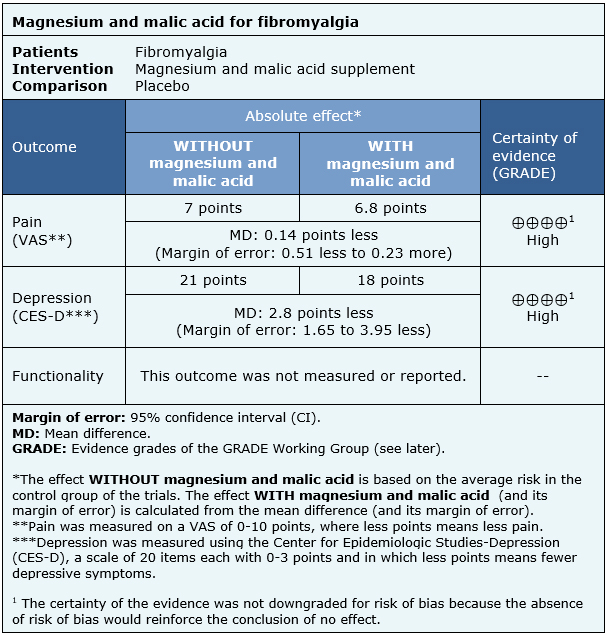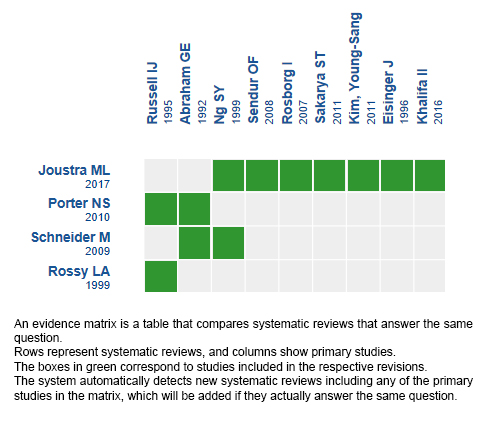Epistemonikos summaries
← vista completaPublished on May 28, 2019 | http://doi.org/10.5867/medwave.2019.04.7632
Magnesium and malic acid supplement for fibromyalgia
Suplemento de magnesio y ácido málico para fibromialgia
Abstract
INTRODUCTION Fibromyalgia is characterized by myalgia and a combination of different symptoms including pain, fatigue, insomnia, morning rigidity, depression and a reduction in every-day functioning. Its aetiology is not clear, but it has been suggested that deficiency in certain minerals such as magnesium may play a role both in the physiopathology and in contributing to the symptoms.
METHODS We searched in Epistemonikos, the largest database of systematic reviews in health, which is maintained by screening multiple information sources, including MEDLINE, EMBASE, Cochrane, among others. We extracted data from the systematic reviews, reanalyzed data of primary studies, conducted a meta-analysis and generated a summary of findings table using the GRADE approach.
RESULTS AND CONCLUSIONS We identified seven systematic reviews which included 11 primary studies of which one was a randomized trial. Our conclusion is that the use of magnesium and malic acid in patients with fibromyalgia makes little or no difference on pain and on depressive symptoms.
Problem
Fibromyalgia is a nonarticular rheumatic syndrome characterized by myalgia and multiple points of focal muscle tenderness to palpation (trigger points). This condition is often associated with general symptoms, such as sleep disturbances, fatigue, stiffness, headaches, and depression. It has a relatively high global incidence (0.5 to 5%) and affects mainly women aged 20 to 50 years [1].
Although research into this syndrome is increasing, the aetiology is not clear, although the symptoms are thought to be due to nociceptive or neurogenic mechanisms. The peripheral pain is stimulated at a spinal level through a combination of central hyperexcitability and a lack of descending inhibitory control [2].
Magnesium is involved in the modulation of muscle contraction and the regulation of enzyme reactions related to energy metabolism, neurotransmission and cerebral activity. In addition as a trace element, it has a role in the synthesis of ATP and in regulating muscle metabolism. it has been suggested that it may have a role in the physiopathology of fibromyalgia and may contribute to the reduction of symptoms.
Malic acid also has a role in the synthesis of ATP as it contributes to the stability of the mitochondrial membrane, to mitochondrial respiration and oxidative phosphorylation.
Methods
We searched in Epistemonikos, the largest database of systematic reviews in health, which is maintained by screening multiple information sources, including MEDLINE, EMBASE, Cochrane, among others, to identify systematic reviews and their included primary studies. We extracted data from the identified reviews and reanalyzed data from primary studies included in those reviews. With this information, we generated a structured summary denominated FRISBEE (Friendly Summary of Body of Evidence using Epistemonikos) using a pre-established format, which includes key messages, a summary of the body of evidence (presented as an evidence matrix in Epistemonikos), meta-analysis of the total of studies when it is possible, a summary of findings table following the GRADE approach and a table of other considerations for decision-making.
|
Key messages
|
About the body of evidence for this question
|
What is the evidence. |
We found seven systematic reviews [4], [5], [6], [7], [8], [9], [10] which included 11 primary studies [3], [11], [12], [13], [14], [15], [16], [17], [19], [20], [21] of which only one was a randomized controlled trial [11]. The table and thesummary are based on the randomized trial [11], as the observational studies did not increase the certainty of the existing evidence nor added any additional relevant information. |
|
What types of patients were included* |
The trial [11] included 24 patients with a diagnosis of primary fibromyalgia according to the clinical guideline of 1990 of the American College of Rheumatology. The average age of the participants was 49 years old. 87.5% of the participants were female. No exclusion criteria were specified. No other information about the participants, such as severity of their symptoms or plasmatic levels of magnesium or malic acid was available from the systematic reviews. |
|
What types of interventions were included* |
This crossover double blind trial [11] evaluated the use of Super Malic (200 mg malic acid + 50 mg magnesium), 3 tablets taken orally twice a day for 4 weeks, compared to placebo, 3 tablets taken orally twice a day for 4 weeks. The participants were randomly assigned to either the medication and placebo for four weeks, followed by a two week washout period where they took no medication. After the double blinded trial, the participants had another two-week wash-out period with no medication and then entered a six month open-label dose escalation trial. |
|
What types of outcomes |
The trials evaluated multiple outcomes, which were grouped by the systematic reviews as follows:
The outcomes were measured at weeks 0, 4, 6, 10 and 12. |
* The information about primary studies is extracted from the systematic reviews identified, unless otherwise specified.
Summary of findings
The information about the effects of magnesium and malic acid is based on only one trial that included 24 participants [11].
This trial [11] reported pain (24 patients) and depression (24 patients). Functionality was not analyzed by any of the systematic reviews.
The summary of findings is as follows:
- The use of magnesium and malic acid in patients with fibromyalgia makes little or no difference on pain (high certainty evidence).
- The use of magnesium and malic acid in patients with fibromyalgia makes little or no difference on depression (high certainty evidence).

| Follow the link to access the interactive version of this table (Interactive Summary of Findings – iSoF) |

Other considerations for decision-making
|
To whom this evidence does and does not apply |
|
| About the outcomes included in this summary |
|
| Balance between benefits and risks, and certainty of the evidence |
|
| Resource considerations |
|
| What would patients and their doctors think about this intervention |
|
|
Differences between this summary and other sources |
|
| Could this evidence change in the future? |
|
How we conducted this summary
Using automated and collaborative means, we compiled all the relevant evidence for the question of interest and we present it as a matrix of evidence.

Follow the link to access the interactive version: Magnesium and malic acid for fibromyalgia.
Notes
The upper portion of the matrix of evidence will display a warning of “new evidence” if new systematic reviews are published after the publication of this summary. Even though the project considers the periodical update of these summaries, users are invited to comment in Medwave or to contact the authors through email if they find new evidence and the summary should be updated earlier.
After creating an account in Epistemonikos, users will be able to save the matrixes and to receive automated notifications any time new evidence potentially relevant for the question appears.
This article is part of the Epistemonikos Evidence Synthesis project. It is elaborated with a pre-established methodology, following rigorous methodological standards and internal peer review process. Each of these articles corresponds to a summary, denominated FRISBEE (Friendly Summary of Body of Evidence using Epistemonikos), whose main objective is to synthesize the body of evidence for a specific question, with a friendly format to clinical professionals. Its main resources are based on the evidence matrix of Epistemonikos and analysis of results using GRADE methodology. Further details of the methods for developing this FRISBEE are described here (http://dx.doi.org/10.5867/medwave.2014.06.5997)
Epistemonikos foundation is a non-for-profit organization aiming to bring information closer to health decision-makers with technology. Its main development is Epistemonikos database (www.epistemonikos.org).
Potential conflicts of interest
The authors do not have relevant interests to declare.

